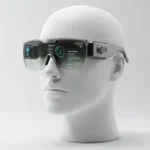Top 5 Hurdles: Common Smart Glasses Problems Users Face
Smart glasses are undeniably cool. They promise to seamlessly blend our digital lives with the real world, offering everything from hands-free calls to instant photo captures. However, like any emerging technology, they come with their quirks. If you’re encountering issues with your smart glasses, rest assured, you’re not alone! Here are the five most common smart glasses problems users face and what you can do about them:
The Ever-Elusive Connection: Bluetooth & Wi-Fi Woes:
The Problem: Perhaps the most frustrating issue is when your smart glasses just won’t connect. Whether it’s struggling to pair with your smartphone via Bluetooth, or constantly dropping Wi-Fi for updates and streaming, connectivity problems can render your smart glasses useless. This often manifests as choppy audio during calls, failed photo uploads, or inability to use AI features. (Smart Glasses Not Pairing – How to fix it?)
Why it Happens: Interference from other devices, outdated Bluetooth drivers on your phone, or simply being too far from your connected device can cause these hiccups. Wi-Fi issues can stem from weak signals or network compatibility problems.
Your Fixes:
- Restart Everything: The classic tech support advice often works. Restart both your smart glasses and your smartphone.
- Check Proximity: Ensure your glasses are close to your phone (within 10 meters is ideal for Bluetooth).
- Clear the Airwaves: Temporarily turn off other Bluetooth devices nearby to reduce interference.
- Forget and Re-pair: Go into your phone’s Bluetooth settings, “forget” your smart glasses, and then try pairing them again from scratch.
- Wi-Fi Troubleshoot: For Wi-Fi, try connecting to a different network or restarting your router. Disable any VPNs on your phone if you’re experiencing issues with livestreaming or video calls.
- Update Apps and Firmware: Ensure both your smart glasses companion app and the glasses’ firmware are updated to the latest versions.
The Great Battery Drain: Short Lifespan & Charging Headaches
The Problem: Smart glasses pack a lot of technology into a small frame, and that often comes at the cost of battery life. Users frequently complain about rapid battery drain, especially when using power-intensive features like video recording, constant AI listening, or continuous music streaming. Beyond usage, some experience issues with the glasses not charging properly in their case or the case itself failing to hold a charge. (Boost Your Smart Glasses Battery Life)
Why it Happens: Features like active microphones for voice commands, continuous display usage, and powerful processors consume a lot of energy. Environmental factors (extreme temperatures) and even unstable connections can accelerate battery drain.
Your Fixes:
- Manage Feature Usage: Be mindful of how long you’re recording video or using features that keep the display active.
- Optimize Settings: Reduce display brightness if possible. Limit unnecessary notifications that wake up the glasses.
- Disable “Always-On” Features: If your glasses have an “always listening” AI feature, consider disabling it or setting it to activate with a physical gesture if battery life is critical.
- Proper Charging Habits: Avoid letting the battery fully drain to 0% frequently. Try to keep it between 20% and 80% for long-term health.
- Clean Contacts: Ensure the charging contacts on both your glasses and the case are clean and free of debris.
- Check Case Charge: Make sure your charging case itself is fully charged.
Software Shenanigans: Bugs, Lag, and Failed Updates
The Problem: From frozen screens to unresponsive controls, software glitches can seriously mar the smart glasses experience. You might encounter frustrating lags when issuing commands, apps that crash, or even critical firmware updates that fail to install, leaving your device in a less-than-optimal state.
Why it Happens: Software is complex, and bugs can arise. Incompatible app versions, insufficient storage, or interruptions during updates are common culprits.
Your Fixes:
- Force Restart: If your glasses are frozen, perform a force restart (refer to your specific model’s manual for instructions, as this usually involves a button combination).
- Check for App Updates: Ensure the companion app on your phone is the latest version. (How to Update Smart Glasses Software?)
- Clear Cache/Reinstall App: If the app is acting up, try clearing its cache or even reinstalling it.
- Perform Firmware Updates Reliably: When performing firmware updates, ensure your glasses are fully charged and connected to a stable Wi-Fi network. Do not interrupt the process.
- Factory Reset (Last Resort): If all else fails, a factory reset can sometimes resolve persistent software issues. Be aware that this will erase all data on your glasses.
The Fit Factor: Comfort, Weight, and Eye Strain
The Problem: Smart glasses, by their nature, are worn on your face for extended periods. This can lead to discomfort, pressure points around the ears or nose, and even headaches. For augmented reality (AR) glasses, users might also experience digital eye strain from focusing on close-up displays while simultaneously interacting with the real world.
Why it Happens: The added weight of components (battery, camera, processor) can make smart glasses heavier than traditional eyewear. Design limitations may not accommodate all head shapes, and prolonged screen use can tire the eyes.
Your Fixes:
- Adjust for Fit: Ensure your smart glasses are properly adjusted to your face. Many models offer different nose pads or ear tips for a more customized fit.
- Take Breaks: Just like with any screen, give your eyes a break. Follow the “20-20-20 rule”: every 20 minutes, look at something 20 feet away for 20 seconds.
- Check Display Brightness: If your glasses have a display, adjust its brightness to a comfortable level, especially in varying lighting conditions.
- Consider Prescription Lenses: If you wear prescription glasses, ensure your smart glasses can accommodate your lenses, or consider models that offer prescription inserts to prevent visual discomfort.
- Ergonomic Design Awareness: When purchasing, pay attention to the weight and design of the glasses to ensure they suit your comfort preferences.
Capture & Sound Quality: Camera, Microphone, and Speakers
The Problem: While smart glasses promise convenient hands-free capture and audio, users sometimes find the camera quality lacking in certain conditions, or the microphone and speakers delivering subpar performance. This can mean blurry photos, muffled audio in recordings, or difficulty hearing during calls. (How to Capture Photos and Videos with Smart Glasses?)
Why it Happens: Miniaturized cameras and microphones can have limitations in low light or noisy environments. Open-ear audio designs, while offering situational awareness, may not provide the same immersion or volume as traditional headphones.
Your Fixes:
- Optimal Lighting: For photos and videos, try to capture in well-lit environments for the best results.
- Clean Lenses/Mics: Gently clean camera lenses and microphone openings to ensure there’s no dust or debris obstructing them.
- Speak Clearly: When using voice commands or making calls, speak clearly and directly towards the glasses.
- Check Audio Settings: Explore the companion app for any audio settings that might enhance volume or clarity.
- Understand Design Limitations: Be aware that open-ear audio designs are meant to allow you to hear your surroundings, so they won’t offer the same immersive sound as closed-back headphones.
- Firmware Updates: Manufacturers often release updates that improve camera and audio performance, so keep your glasses’ firmware up to date.
Smart glasses are an exciting step into the future, and while these common problems can be frustrating, most have straightforward solutions. By understanding these smart glasses problems and knowing how to address them, you can maximize your smart glasses experience and truly embrace the blend of technology and reality they offer.
Frequently Asked Questions about Smart Glasses Problems
Here are answers to some of the most common questions we receive regarding smart glasses problems.
General Troubleshooting Smart Glasses Problems
Q1: My smart glasses won’t turn on. What should I do? A1: First, ensure your glasses are fully charged. Place them in their charging case and check the case’s indicator light (usually green or solid) to confirm charging. If they still don’t turn on after a full charge, try performing a force restart (refer to your specific model’s user manual for the exact button combination, as it varies by brand). If the issue persists, clean the charging contacts on both the glasses and the case with a dry cotton swab.
Q2: My smart glasses are constantly disconnecting from my phone. How can I fix this? A2: Intermittent disconnections are often due to Bluetooth interference or distance. Try these steps: * Ensure Proximity: Keep your phone and glasses close (within 10 meters/30 feet) without significant obstructions. * Minimize Interference: Temporarily turn off other Bluetooth devices in the vicinity. * Forget & Re-pair: Go to your phone’s Bluetooth settings, “forget” or “unpair” your smart glasses, then re-initiate the pairing process. * Restart Both Devices: A simple restart of both your phone and smart glasses can often resolve minor glitches. * Update Software: Make sure both your phone’s operating system and the smart glasses companion app are updated.
Q3: My smart glasses seem to be draining battery very quickly. Is this normal? A3: Battery life varies significantly based on usage. Continuous use of power-intensive features like video recording, constant AI voice commands, or streaming music will deplete the battery much faster than casual use. * Manage Features: Limit the duration of video recording, live streaming, or continuous voice assistant use if you need extended battery life. * Adjust Brightness: If your glasses have a display, lowering the brightness can save power. * Disable Unused Features: Turn off features like “always-on” voice commands or notifications if you don’t need them constantly. * Check for Updates: Software updates often include battery optimization improvements.
Software & Performance
Q4: My smart glasses’ software feels slow or buggy. What can I do to improve performance? A4: Software glitches can be frustrating. Try these solutions: * Restart: Perform a simple restart of your smart glasses. * Update Firmware: Always keep your smart glasses’ firmware updated. Manufacturers frequently release updates that fix bugs and improve performance. * Update Companion App: Ensure the smart glasses app on your phone is also updated to its latest version. * Clear Cache (if applicable): Some companion apps allow you to clear their cache, which can resolve performance issues. * Factory Reset: As a last resort for persistent software issues, a factory reset (which wipes all data) can often resolve deep-seated bugs. Always back up any important data first.
Q5: My voice commands aren’t working accurately or consistently. A5: Inaccurate voice commands can be due to several factors: * Microphone Obstruction: Check if the microphone ports on your glasses are clean and clear of debris. * Speaking Clearly: Ensure you are speaking clearly and at a normal volume directly towards the glasses. * Noisy Environments: Voice recognition can struggle in loud or windy environments. Try using commands in a quieter setting. * Internet Connection: For AI-powered commands, a stable internet connection (via Wi-Fi or your phone’s data) is crucial. * Software Updates: Ensure your glasses’ firmware is up to date, as AI and voice recognition improvements are common in updates.
Comfort & Physical Issues
Q6: My smart glasses feel uncomfortable or cause pressure points after wearing them for a while. A6: Comfort is key for wearables. * Adjust Fit: Many smart glasses come with different nose pads or temple tips. Experiment with these to find the most comfortable fit for your face. * Take Breaks: Remove the glasses periodically to give your face and eyes a rest. * Professional Adjustment: If discomfort persists, consider visiting an optician or the manufacturer’s service center (if available) for professional adjustment. * Weight Distribution: Be aware that smart glasses are heavier than regular glasses; your face may need time to adjust.
Q7: How do I clean my smart glasses safely, especially the lenses and electronic parts? A7: Proper cleaning is essential to avoid damage: * Detach Components (if possible): Some models allow you to detach the front frame from the temples for easier cleaning. Refer to your manual. * Lenses: Use an alcohol-free lens cleaner and a microfiber cloth specifically designed for eyeglasses. Avoid abrasive materials or paper towels. * Frame & Electronics: Use a soft, dry, lint-free cloth. For contact points or hard-to-reach areas, a dry cotton swab can be useful. * Avoid Liquids & Chemicals: Never rinse smart glasses under running water or submerge them. Avoid using harsh chemicals, acetone, or abrasive cleaners, as these can damage coatings and electronics. * Check IP Rating: Be aware of your glasses’ IP (Ingress Protection) rating. An IP54 rating means they are protected against dust and water splashes, but not immersion.
Other Concerns
Q8: Can I get prescription lenses for my smart glasses? A8: Many smart glasses models offer options for prescription lenses. This might involve: * Directly Ordering: Some manufacturers allow you to order the glasses with your prescription lenses. * Prescription Inserts: Other models use clip-in or attachable prescription inserts. * Third-Party Opticians: You might be able to take your smart glasses to a compatible optician who can fit custom prescription lenses. Always check with the manufacturer first to ensure compatibility and avoid voiding your warranty.
Q9: I’m concerned about privacy when using my smart glasses, especially the camera. What should I know? A9: Privacy is a valid concern with camera-equipped smart glasses. * Recording Indicators: Most smart glasses have a visible LED light that illuminates when the camera is recording. Be aware of this light and ensure it’s not obstructed. * Inform Others: It’s good practice to inform people around you if you are recording. * Respect Privacy: Always be mindful of your surroundings and avoid recording individuals without their consent, especially in private settings. * Manufacturer Policies: Familiarize yourself with the privacy policies of your smart glasses manufacturer to understand how your data is collected and used.
This FAQ section provides concise answers to common smart glasses problems, directly addressing user pain points. By including practical, actionable advice, you enhance the usefulness and trustworthiness of your website.
Additional helpful information
More information about improving your smart glasses battery life – Boost Your Smart Glasses Battery Life




